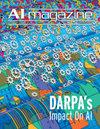设计中的预期思维
IF 2.5
4区 计算机科学
Q3 COMPUTER SCIENCE, ARTIFICIAL INTELLIGENCE
引用次数: 0
摘要
预期思维和设计有许多共同点。我们确定了所有计算AT系统面临的三个挑战:表示、生成和评估。我们讨论了现有的人工智能技术如何提供一些解决这些问题的方法,但也明显不足。接下来,我们将阐明AT概念在三种计算设计范式中的表现:配置设计、弹性设计和概念设计。最后,我们在at和设计的交叉点上确定了两个有前景的未来方向:为其他人建模和支持人类决策者的新界面。本文章由计算机程序翻译,如有差异,请以英文原文为准。

Anticipatory thinking in design
Anticipatory thinking (AT) and design have many commonalities. We identify three challenges for all computational AT systems: representation, generation, and evaluation. We discuss how existing artificial intelligence techniques provide some methods for addressing these, but also fall significantly short. Next, we articulate where AT concepts appear in three computational design paradigms: configuration design, design for resilience, and conceptual design. We close by identifying two promising future directions at the intersection of AT and design: modeling other humans and new interfaces to support human decision-makers.
求助全文
通过发布文献求助,成功后即可免费获取论文全文。
去求助
来源期刊

Ai Magazine
工程技术-计算机:人工智能
CiteScore
3.90
自引率
11.10%
发文量
61
审稿时长
>12 weeks
期刊介绍:
AI Magazine publishes original articles that are reasonably self-contained and aimed at a broad spectrum of the AI community. Technical content should be kept to a minimum. In general, the magazine does not publish articles that have been published elsewhere in whole or in part. The magazine welcomes the contribution of articles on the theory and practice of AI as well as general survey articles, tutorial articles on timely topics, conference or symposia or workshop reports, and timely columns on topics of interest to AI scientists.
 求助内容:
求助内容: 应助结果提醒方式:
应助结果提醒方式:


